Description
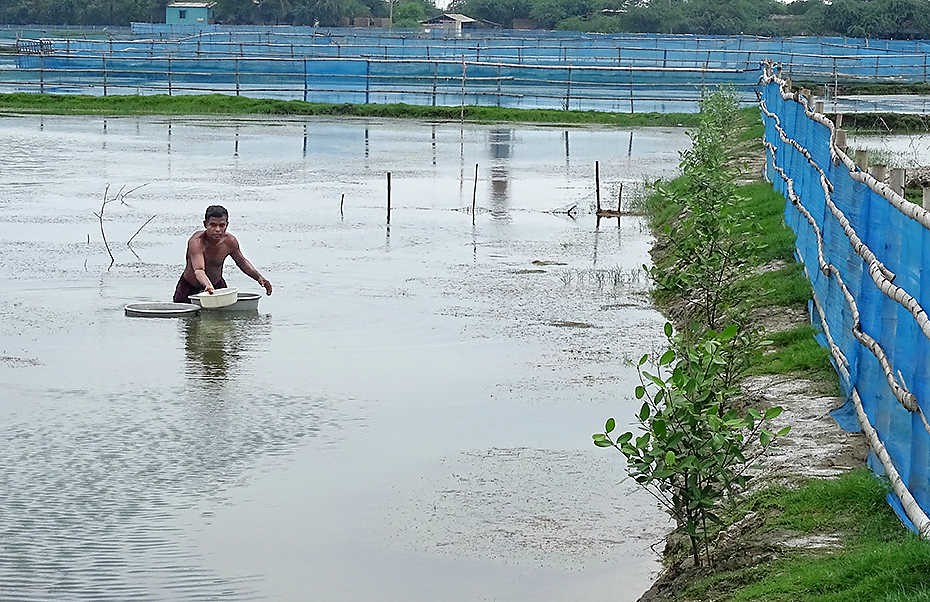
Copyright infringement not intended
Context: A new initiative of sustainable shrimp cultivation provides hope for mangrove restoration in the Sundarbans. For several years, environmentalists and experts have expressed concern over unsustainable aquaculture, particularly shrimp collection, after cleaning large tracts of mangrove forests in the Sundarbans.
Details:
- Under the initiative, Sustainable Aquaculture In Mangrove Ecosystem (SAIME), farmers have taken up cultivation of shrimp on 20 hectares at Chaital in West Bengal’s North 24 Parganas, and 10 hectares at Madhabpur in adjoining South 24 Parganas. However, they are doing their part in restoring the mangroves as well.
- The community-based initiative of sustainable shrimp cultivation is being conceived by NEWS and Global
- Shrimp cultivation is integrated into the mangrove ecosystem but when people extended the fisheries inwards, they excluded the mangroves.
- The rate of survival of planted mangrove saplings, which is usually 5-10%, has ranged between 30% and 50% in the initiative.
- Fishing, particularly shrimp cultivation, is one of the key occupations of the people of the Sundarbans, which is a complex network of rivers and low-lying islands that face a tide surge twice a day.
- Shrimp cultivation is practised in 15,000 to 20,000 hectares of the unique ecosystem in India. The Sundarbans forest is about 10,000 sq. km across India and Bangladesh, of which 40% lies in India.
- There are 42 shrimp farmers engaged in the pilot project and a majority of them say that they have had higher incomes compared to previous years.
Mangrove
- A mangrove is a shrub or tree that grows in coastal saline or brackish water. There are about 80 different species of mangrove trees. All of these trees grow in areas with low-oxygen soil, where slow-moving waters allow fine sediments to accumulate.
Importance of Mangroves
Stabilize Coastline
- Mangrove forests stabilize the coastline by reducing erosion caused by storm surges, currents, waves and tides.
Remove Pollutants
- Mangroves protect water quality by removing nutrients and pollutants from stormwater runoff before they reach seagrass habitats and coral reefs. The mangroves' complex root systems filter nitrates and phosphates that rivers and streams carry to the sea. They also keep seawater from encroaching on inland waterways.
Reduces Coastal Flooding
- Mangrove peat absorbs water during heavy rains and storm surge, reducing the chances of coastal flooding.
Nursery Grounds
- Mangroves provide nursery habitat for many commercial fish and shellfish, and thus contribute to the local abundance of seafood.
- Mangrove systems provide shelter to a range of wildlife species including birds, deer and honey bees.
Nestling to Coastal Birds
- Mangroves serve as nesting areas for coastal birds such as little blue herons, great egrets and brown pelicans. Many birds depend on mangroves for part of their seasonal migrations. Even dead mangroves play an important role, providing roosting areas for bird species.
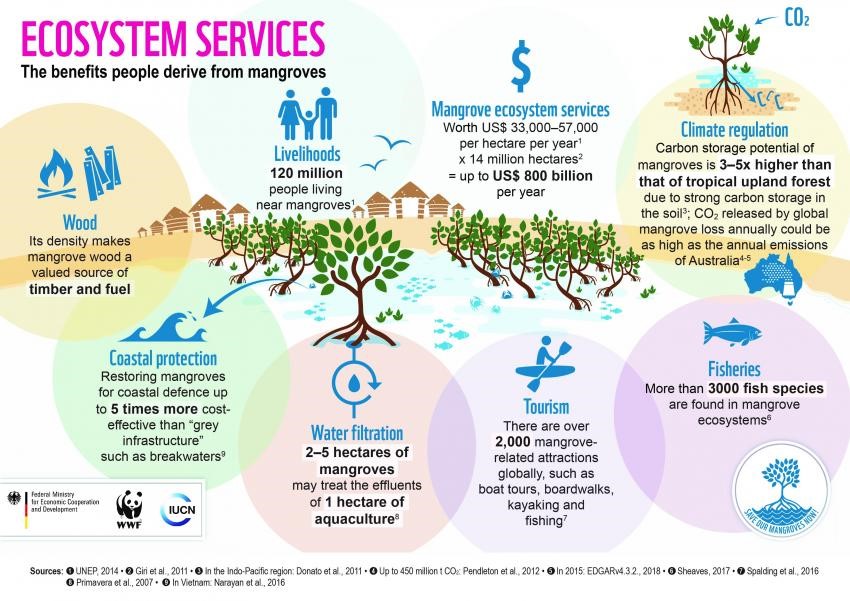
Shelter from the storm
- The thickets of mangroves that buttress tidal mudflats also provide a buffer zone that protects the land from wind and wave damage.
- Places, where mangroves have been cut down for shrimp farms, are far more vulnerable to destructive cyclones and tidal waves.
Resources for humans
- Mangrove forests provide many of the resources upon which coastal people depend for their survival and livelihood. At low tide, people can walk across the tidal flats to collect clams, shellfish, and shrimp. At high tide, fish move in to feed among the protection of mangrove roots, turning the marshy land into rich fishing grounds. The mangrove trees themselves provide fuel, medicines, tannins, and wood for building houses and boats.
Food for the multitudes
- The tons of leaves that fall from each acre of mangrove forest every year are the basis of an incredibly productive food web. As the leaves decay, they provide nutrients for invertebrates and algae. These in turn feed many small organisms, such as birds, sponges, worms, anemones, jellyfish, shrimp, and young fishes. Tides also circulate nutrients among mudflats, estuaries, and coral reefs, thus feeding species like oysters that rest on the seabed.
.jpeg)
Keystone of a coastal ecosystem
- Mangroves, seagrass beds, and coral reefs are often found together and work in concert. The trees trap sediment and pollutants that would otherwise flow out to sea. Seagrass beds provide a further barrier to silt and mud that could smother the reefs. In return, the reefs protect the seagrass beds and mangroves from strong ocean waves. Without mangroves, this incredibly productive ecosystem would collapse.
Carbon Sink
- Mangroves also have a big impact on climate. Mangroves are also great carbon sinks. They isolate carbon at two to four times the rate of tropical forests like the Amazon and store three to five times more carbon per equivalent area than tropical forests.
Where are mangrove ecosystems found?
- Mangroves can be found in the tropical and subtropical regions of the world.
- Asia has the largest coverage of the world’s mangroves, followed by Africa, North and Central America, Oceania and South America.

In India:
- The deltas of the Ganges, Mahanadi, Krishna, Godavari, and the Cauveryrivers contain mangrove forests.
- The backwaters in Kerala have a high density of mangrove forest.
- The Sundarbans in West Bengal is the largest mangrove region in the world and a UNESCO World Heritage Site. It spans from the Hooghly River in West Bengal to the Baleswar River in Bangladesh.
- The Bhitarkanika mangrove system in Odisha is India’s second largest mangrove forest. Pichavaram in Tamil Nadu has a vast expanse of water covered with mangrove forests. It is home to many aquatic bird species.

Loss of Mangroves over the years
- More than 40 percent of the global area of mangroves is in four countries: Indonesia (19 percent of the global total), Brazil (9 percent), Nigeria (7 percent) and Mexico (6 percent). Globally, the area of mangroves decreased by 1.04 million ha between 1990 and 2020 – FAO Report.
- The Western Indian Ocean region lost around 4% its mangrove forests over the past quarter-century - Wetlands International.
- The world has thus lost 5 million ha of mangrovesover the last twenty years, or 25 percent of the extent found in 1980- FAO Report.
- India has lost 40% of its mangrove area in the last century, mainly due to agriculture, aquaculture, tourism, urban development, and overexploitation, researchers from the Indian Institute of Science have found.
Threats to Mangroves
Pollution
Waste discharges from the trawlers, fishing boats and cargoes, unchecked sludge disposal from the industries add to already contaminated water in the rivers of the Sundarbans delta.
Nutrient enrichment
- Although mangroves have been proposed to protect the marine environment from land-derived nutrient pollution, nutrient enrichment can have negative consequences for mangrove forests and their capacity for retention of nutrients may be limited.
Coastal Development
- Coastal development may be the primary threat to mangroves. Not only are the forests lost when a coast is developed, but a man-made structure almost always replaces them.
Aquaculture, Agriculture & Salt Production
- The close proximity of mangroves to the ocean makes them ideal locations for shrimp farming and other kinds of mariculture.
- As a result, hundreds of thousands of hectares of mangrove forests have been cleared, and the hydrology has been altered, in order to intensify commercial production of shrimp and other species, cultivate agricultural crops, and create salt ponds.
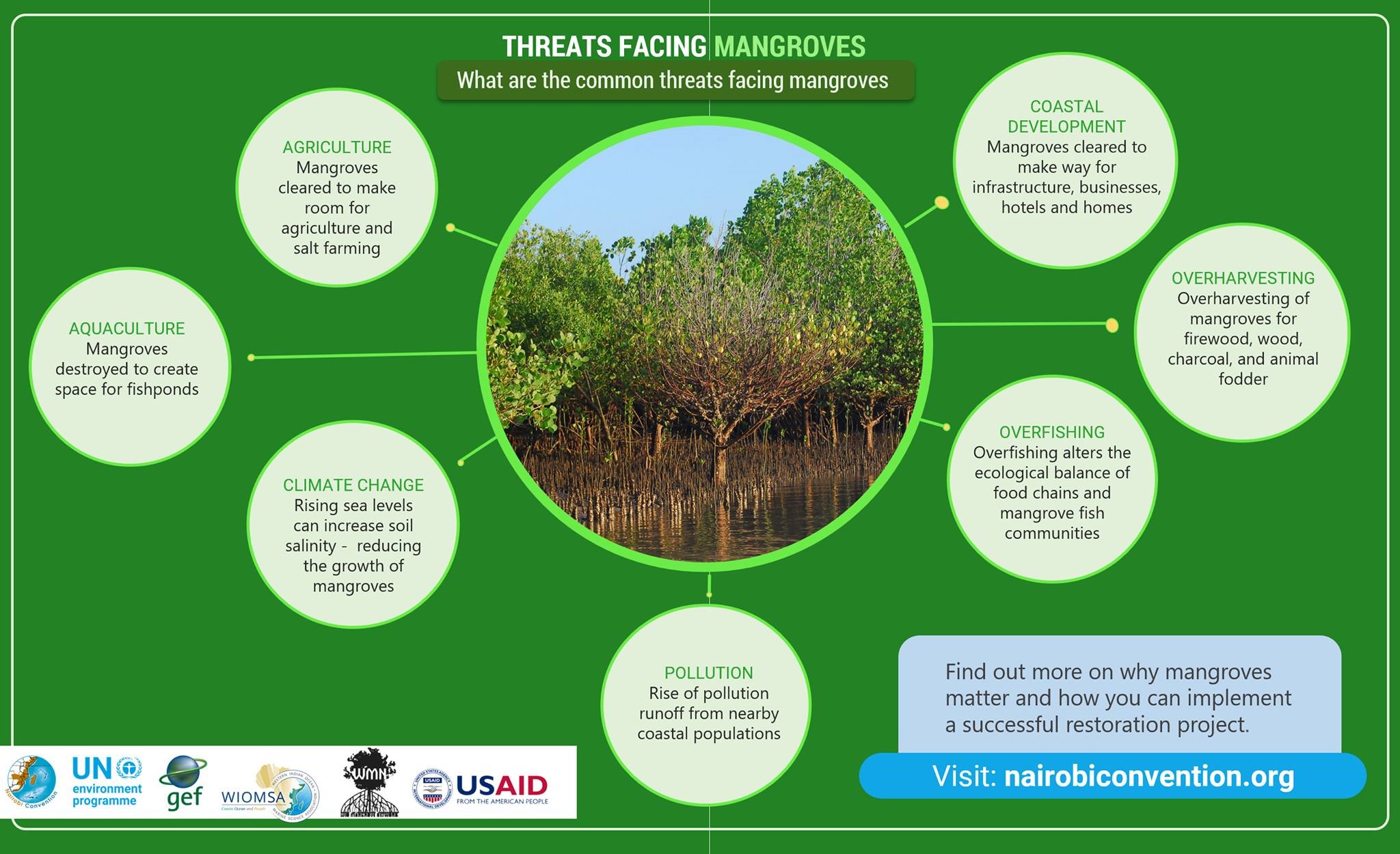
Climate Change
- Climate change is causing two important impacts along the world’s coastlines. Sea levels are rising and the chemistry of the oceans is shifting (IPCC 2007 and NRC 2011). The rates at which these impacts are occurring is likely to exceed the ability of mangrove forests and the species that live within them to adapt.
- Losing them will cause even greater carbon releases, creating a positive feedback loop that will further exacerbate sea level rise and increased ocean acidity.
Deforestation
- Most destructive uses of mangrove forests require their removal. The motivations behind deforestation include direct use of the mangrove wood and leaf products, use of the wetland habitat, or complete fill and conversion for coastal developments.
- Deforestation for fuel & timber accounts for the ongoing loss of approximately 26 percent of existing mangroves.
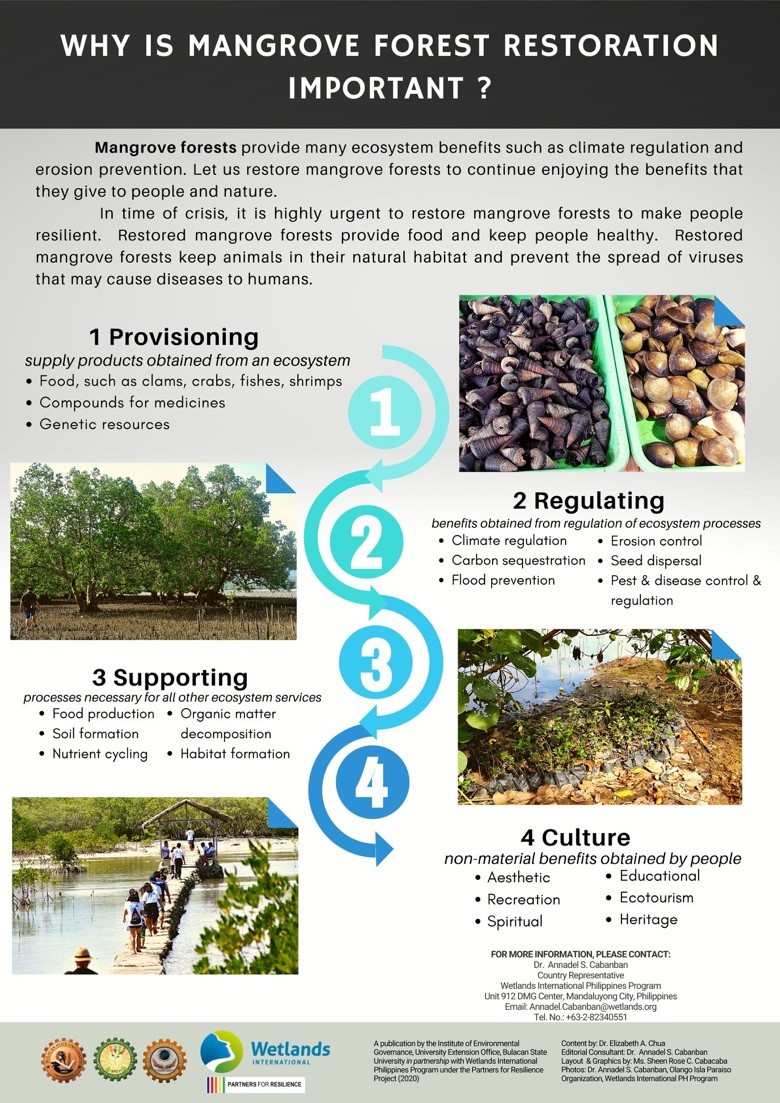
Steps being taken and Way Ahead
- The Global Mangrove Alliance (GMA) is a commitment from the international community to reverse the loss of critically important mangrove habitats worldwide. The GMA has the ambitious goal of expanding the global extent of mangrove habitat by 20 percent by 2030.
- India is implementing a Central Sector Scheme under National Coastal Mission Programme on ‘Conservation and Management of Mangroves and Coral Reefs’. Under this programme, annual Management Action Plan (MAP) for conservation and management of mangroves are formulated and implemented in all the coastal States and Union Territories.
Need of the hour
- Better connecting mangrove ecosystems with the role, they play in the global carbon cycle and climate system could change the economic calculus for mangroves.
- The role of mangroves in climate change adaptation and disaster risk reduction should be integrated in local and national adaptation plans.
- The key role of mangroves as carbon stores and sinks needs to be highlighted in national and international strategies that address climate change.
- Enhance existing carbon stocks and reverse CO2 emissions by increasing protection and restoration of mangrove ecosystems, and build mangroves into emissions trading and climate change mitigation planning.

Case Study
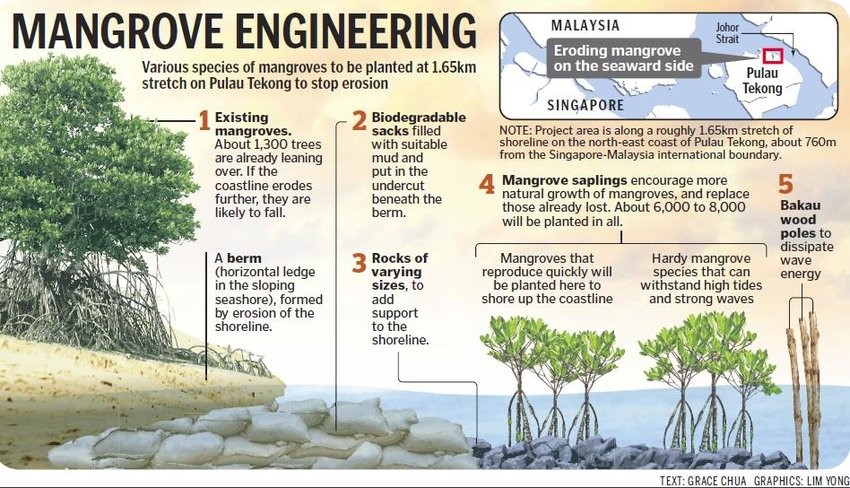
Sunderbans
- Sundarbans is a mangrove areain the delta formed by the confluence of the Ganges, Brahmaputra and Meghna Rivers in the Bay of Bengal.
- It comprises closed and open mangrove forests, land used for agricultural purpose, mudflats and barren land, and is intersected by multiple tidal streams and channels.
- Four protected areas in the Sundarbans are enlisted as UNESCO World Heritage Sites, viz. Sundarbans National Park, Sundarbans West, Sundarbans South and Sundarbans East Wildlife Sanctuaries.
- Despite these protections, the Indian Sundarbans were considered endangered in a 2020 assessment under the IUCN Red List of Ecosystems framework
Shrimp
- Shrimp, any of the approximately 2,000 species of the suborder Natantia (order Decapoda of the class Crustacea).
- Close relatives include crabs, crayfish, and lobsters.
- Shrimp are characterized by a semitransparent body flattened from side to side and a flexible abdomen terminating in a fanlike tail.
- The appendages are modified for swimming, and the antennae are long and whiplike.
- Shrimp occur in all oceans—in shallow and deep water—and in freshwater lakes and streams.
- Many species are commercially important as food.
- Shrimp range in length from a few millimetres to more than 20 cm (about 8 inches); average size is about 4 to 8 cm (1.5 to 3 inches). Larger individuals are often called prawns.
- Shrimp swim backward by rapidly flexing the abdomen and tail. Their food consists mostly of small plants and animals, although some shrimp feed on carrion.
- Freshwater prawns (family Atyidae) occur mainly in warm regions, where some live in brackish water.
https://epaper.thehindu.com/Home/ShareArticle?OrgId=G6HAMT404.1&imageview=0



















